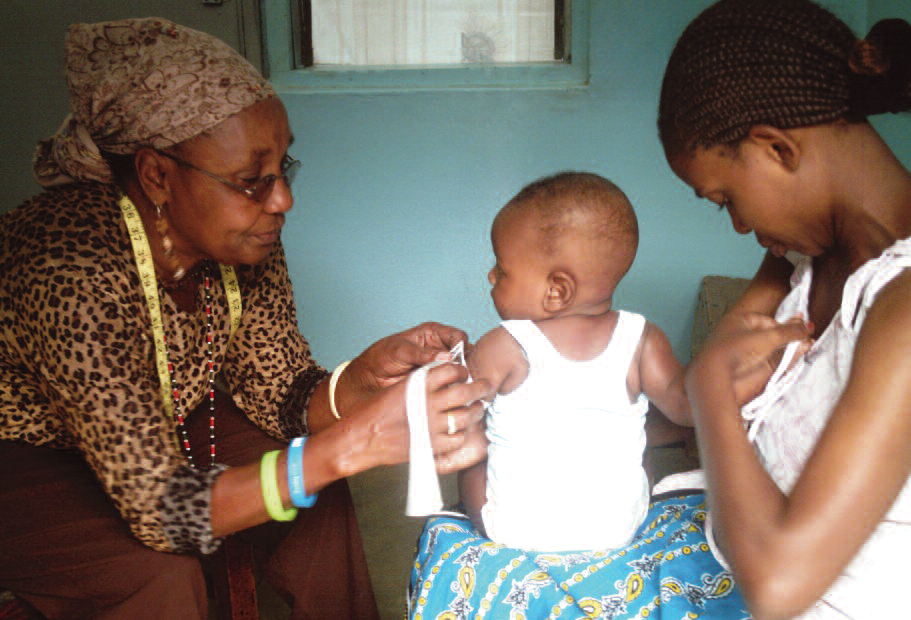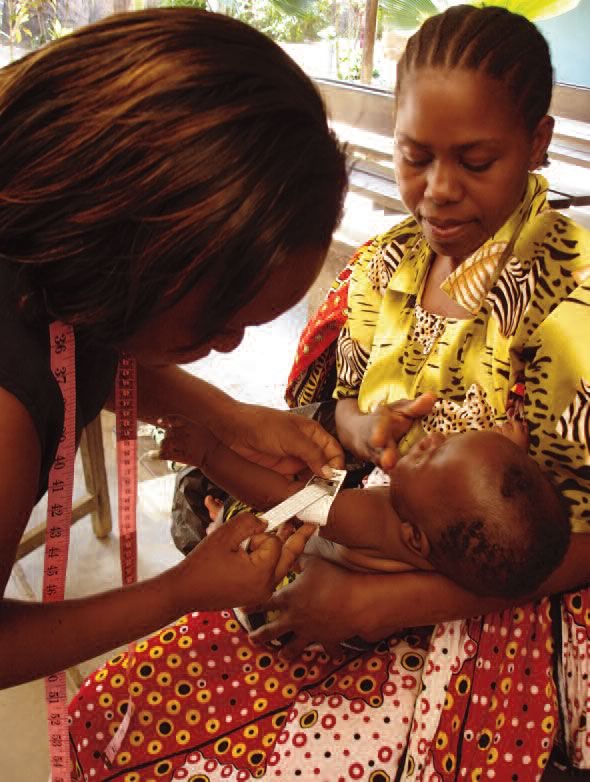Measuring infants aged below 6 months: experience from the field
By Martha Mwangome and James Berkley
 Dr Martha Mwangome is a postdoc researcher at KEMRI/Wellcome Trust Collaborative Programme; Centre for Geographic Medical Research Coast, Kenya. She has a Masters degree in Global Health Sciences from University of Oxford, UK and a PhD degree in nutrition epidemiology from the London School of Hygiene and Tropical Medicine (LSHTM), UK. Her thesis focused on anthropometric assessment of infants under 6 months
Dr Martha Mwangome is a postdoc researcher at KEMRI/Wellcome Trust Collaborative Programme; Centre for Geographic Medical Research Coast, Kenya. She has a Masters degree in Global Health Sciences from University of Oxford, UK and a PhD degree in nutrition epidemiology from the London School of Hygiene and Tropical Medicine (LSHTM), UK. Her thesis focused on anthropometric assessment of infants under 6 months
Dr James Berkley is a consultant paediatrician and sub-specialist in paediatric infectious diseases and immunology at KEMRI/Wellcome Trust Collaborative Programme; Centre for Geographic Medical Research Coast, Kenya, and the Centre for Clinical Vaccinology & Tropical Medicine, University of Oxford, Oxford, UK. At KEMRI he leads a research group focusing on infection and inflammation in childhood malnutrition, and on perinatal health. Areas of research include assessment and management of malnourished infants below 6 months of age.
Location: Kenya
What we know: Anthropometric assessment in infants aged below 6 months present unique measuring challenges. These contribute to caregiver, infant and health worker stress and errors.

What this article adds: A research evaluation explored common challenges in measuring infants below 6 months amongst health workers accustomed to their assessment in rural Kenya. Challenges were caregiver anxiety, fear of hurting very young infants during length measurement, lack of suitable measuring equipment and lack of health worker practical experience. To overcome these, strategies to build trust; to recognise, understand and manage caregivers’ anxiety together with attention to detail (including equipment quality) were identified.
It has been estimated that worldwide 8.5 million infants aged below 6 months are wasted1. Traditionally, infants aged less than 6 months have been excluded from national and regional surveys2 resulting in a general lack of protocol to guide their assessment. Anthropo- metric measurements are prone to errors, however, errors can be minimised by paying attention to all aspects of the measuring process3. Minimising errors builds confidence in findings and their interpretation and therefore forms an inherent component in the use of anthropometry.
Context
Between February 2008 and August 2009, we engaged three nurses, three public health officers and eighteen community health workers (CHWs) in rural Kenya to measure common anthropometry among infants aged less than 6 months. Together, these health workers repeatedly measured the mid-upper arm circumference (MUAC), weight and length of 1226 infants. This exercise was undertaken as part of a study evaluating the reliability and accuracy of common anthropometry among infants below 6 months. Findings of this study have been published elsewhere4. At the end of the data collecting phase and as part of the evaluation process, we engaged the health workers in discussing common challenges faced during field work and strategies they used to overcome them. In this write up, we share challenges specific to measuring infants in a rural community African setting as experienced by our study team and discuss some of the strategies applied within our study to overcome them.
Challenges in measurement
The challenges in measuring infants below 6 months have been categorised into four themes described below.
 Caregivers anxiety with the measuring process
Caregivers anxiety with the measuring process
Health workers observed that caregivers of infants are anxious about the measuring process. In a society where infants are protected and shielded from the outside world, caregivers expressed to the health workers a real fear associated with the request to remove infant’s clothes before measuring. Firstly, there was the perception that the infants’ naked body will be exposed to the external environment which is likely to cause ill health. Secondly, there was concern that unprotected contact between infant’s bare skin and the shared measuring equipment would transmit skin infections from other infants.
Health workers found that engaging caregivers by i) initiating rapport with caregivers at the beginning of the process, ii) continuous engagement with caregivers during the process of measuring and iii) assuring caregiver of the safety of the infant and hygiene of the equipment, facilitated co-operation. For example, while measuring length, health workers lined disposable paper hand towels or caregivers personal scarves on the upper part of the length board, where the head and the body of the infant would lie. This simple gesture ensured comfort of the infant, enhanced the level of hygiene and improved co-operation with caregivers. Health workers also carefully wiped off any urine or other body fluids left on the measuring board by an infant and frequently disinfected the length boards using sanitisers in the presence of the caregivers. These additional precaution measures worked to enhance the level of trust, facilitated approval and co-operation from caregivers.
Infants’ tendency to a fetal position
Health workers observed that newborn infants (less than 3 months old) were generally calm as they would sometimes sleep throughout the measuring process. Older infants were more playful and hence more disruptive during the process. Newborn infants tended to be in a foetal position (curled up with knees bent) and presented a specific challenge while measuring length. In this process, the measurer carefully lays the infant on the length board with their head slightly touching the headboard. In order to estimate the maximum possible length of the infant, it is required that the measurer “applies gently pressure to the knees to straighten the leg”. It is this process of straightening the legs that made most caregivers overly anxious as they feared damaging and even breaking the knees of the infants. Additionally, the process of constraining an infant in a stretched up position on the infantometer tended to induce crying among infants which added to the anxiety already experienced by caregivers.
It is important to note that the fear and anxiety expressed by the caregivers in our sample regarding the length process are not limited to naive populations. For a while, countries like Netherlands had abandoned the measuring of length among newborns because it was thought to be harmful to the development of the hip joint5. However, if instructions are followed, length measurement is not harmful to infants. In fact, the World Health Organisation (WHO) recommend length measurements for all neonates immediately after birth and the new WHO multicentre growth reference study6 and other large neonatal studies including the ongoing International Fetal and Newborn Growth Standards for the 21st Century (intergrowth-21st)7 have length measured in all participating newborns.
In our study, the unfamiliarity of caregivers to the length measurement presented a unique situation. However, health workers felt that creating rapport with caregivers and constantly reassuring them that the procedure is not dangerous to the infant provided a good environment to discuss and understand caregivers’ fears in this process. In addition, health workers involved caregivers in the length measuring process by asking them to assist, i.e. to stand over the head board and hold the head firmly in position ensuring that the head board is only slightly touching the tip of the head. Caregiver’s participation worked to enhance the level of trust and co-operation. Further, health workers avoided measuring an already agitated infant.
Lack of suitable measuring equipment
Measuring equipment is a documented source error and a source of anxiety among caregivers. Health workers observed that faulty measuring equipment, like squeaking weighing machines, chipped off measuring boards and faded MUAC tapes, present technical difficulties in measuring but more importantly, threatened the safety of the infants. They suggested the use of clean, well-maintained, well labelled and calibrated measuring equipment, especially the use ofa proper infantometer for measuring infant’s length, as opposed to a make-shift wooden measuring board which is perceived to be too hard and rough for neonates and infants. The use of proper equipment gives the caregiver’s the impression that health workers are competent and know what they are doing. In exchange, it raises the level of confidence for health workers and enhances trust among caregivers. It also ensures that health workers enjoy the measuring experience and are likely to present more reliable and accurate readings.
Lack of practical measuring experience
Health workers with prior experience in handling newborns and infants, especially those that had children of their own, reported having found it easier to handle and measure infants than those who had little or no prior experience with infants. Health workers with little experience in handling neonates reported having found the process of measuring neonates difficult at first but that with more exposure, the process became manageable. To overcome this challenge, health workers emphasised the importance of the practical session with real neonates as part of the training curriculum. This would highly enhance confidence and expertise and will also enhance reliability of measurements.
Conclusion
Infants aged below 6 months present unique measuring challenges. Both healthcare workers and caregivers may be anxious about possibilities of hurting the infant during measurement of length, but this is not harmful when performed correctly. Building trust, recognising, understanding and managing caregivers’ anxiety while cultivating attention to details will ensure a successful and satisfactory measuring experience.
For more information, contact: Martha Mwangome, email: MMwangome@kemri-wellcome.org
1Kerac, M., Blencowe, H., Grijalva-Eternod, C., et al. 2011. Prevalence of wasting among under 6-month-old infants in developing countries and implications of new case definitions using WHO growth standards: a secondary data analysis. Arch Dis Child, 96, 1008-13
2Lopriore, C., Dop, M. C., Solal-Celigny, A. & Lagnado, G. 2007. Excluding infants under 6 months of age from surveys: impact on prevalence of pre-school undernutrition. Public Health Nutr, 10, 79-87
3Ulijaszek, S. J. & Kerr, D. A. 1999. Anthropometric measurement error and the assessment of nutritional status. Br J Nutr, 82, 165-77.
4Mwangome, M. K., Fegan, G., Mbunya, R., Prentice, A. & Berkley, J. 2012. Reliability and accuracy of anthropometry performed by community health workers among infants under 6 month in rural Kenya. Tropical Medicine and International Health, 7, 622. Also summarised as Anthropometry in infants under 6 months in rural Kenya. Field Exchange, Issue No 44, December 2012. p26. http://fex.ennonline.net/44/kenya
5Engelberts, A. C., Koerts, B., Waelkens, J. J., Wit, J. M. & Burger, B. J. 2005. [Measuring the length of newborn infants]. Ned Tijdschr Geneeskd, 149, 632-6.
6WHO 2006. Reliability of anthropometric measurements in the WHO Multicentre Growth Reference Study. Acta Paediatr Suppl, 450, 38-46.
7INTERGROWTH-21st Anthropometry Group. 2012. ANTHROPOMETRY HANDBOOK [Online]. Available: http://www.medscinet.net/Interbio/Uploads/ProtocolDocs/Draft%20Anthropometry%20
Handbook.pdf [Accessed]
8See footnote 3

